The Four C's
Universally, diamonds are graded and priced according to what is called the "4C's". The "4C's" stand for cut, color, clarity, and carat weight.
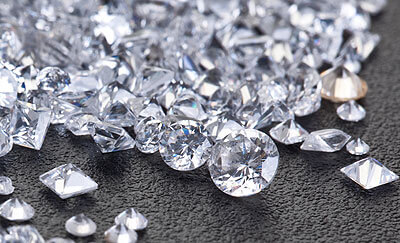
Everything you need to know about diamonds before making your purchase.
1. Cut
The only C that can be altered by a human is the cut of the diamond. A diamond can be crafted, usually by a master diamond cutter with a lot of experience, in various geometric proportions. Facets are cut in the diamond after it's shape has been established. Light is refracted from the facets similar to a prism. This produces the stone's brilliance and fire.
A number of different factors create a well-cut diamond. Angles must be cut very precisely; it is necessary that the facets line up correctly; it must be of the right depth (not too shallow, not too deep). A diamond grading report, provided with various diamonds and made by an independent gemological laboratory, categorizes many of these characteristics by grade.
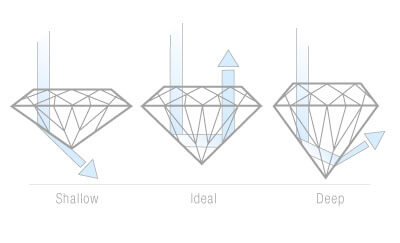
The cut should always be the ideal depth, not too shallow and not too deep.
An "ideal cut" can be established through a precise set of guidelines that gives the proportions to create a diamond with the greatest brilliance and fire. A diamond cut to certain proportions with 58 facets would create the most brilliance and fire.
Evaluating the cut of a diamond is difficult for the average consumer. Consequently, cuts are assigned a grade to make it easier. The typical range of cut grades includes:
Ideal
These diamonds are the best possible cut, nearly perfectly proportioned and reflect virtually all of the light that enters the diamond. Ideal cut diamonds are very rare and valuable.
Very Good
These diamonds reflect almost as much light as an ideal cut diamond but do not meet the preferred proportions exactly. They cost slightly less than ideal cut diamonds.
Good
These diamonds reflect a lot of the light that enters them, but not as much as very good or ideal cut diamonds. In most cases, the cutter chose to create a larger diamond at the expense of a better cut. Good cut diamonds are a budget-friendly option.
Fair
These diamonds fail to reflect a significant amount of light that enters them. While they may be of good size, they are not as brilliant as higher quality cut diamonds.
Poor
These diamonds are cut too shallow or too deep to reflect much light. They are not recommended.
2. Color
Essentially, the less color a diamond has, the more valuable it is, as long as all other factors are equal. Colorless diamonds are also fairly rare. A diamond with the least amount of color sparkles the most with fire and brilliance because the light that enters is refracted very purely. Diamonds may range in color from colorless to yellowish to brown; however, the ideal diamond is colorless.
The Gemological Institute of America's color scale evaluates the color of a diamond as seen through the side of the diamond. Since settings can portray the diamond as being another color, the diamond's color is most accurately determined when it is not mounted in a setting. White gold and platinum settings do not affect the color of the diamond as much as yellow gold settings do. If the diamond is still in its setting, even a professional may not be able to tell the difference between color grades.
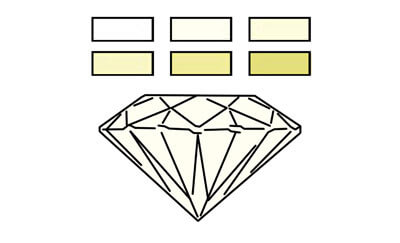
The less color a diamond has, the more valuable it becomes. Colorless diamonds are very rare.
The letters of the alphabet from D through Z are used in the color grading system for diamonds. The following is a description of the letters and the color they represent. The most valuable diamond has a grade of D, and therefore, is absolutely colorless. Remember though, that the color of a diamond is not the only factor towards determining the value of a diamond. For example, a stone with a low color grade, but a superior cut and clarity, may be valued higher than a colorless stone with imperfections. There are several factors including the 4 C's (cut, color, clarity, and carat weight) which determine the value of the diamond.
Diamonds with the lowest color grade of X, Y, and Z are less desirable and generally, less valuable, than diamonds with a D, E, or F color grade. The color of a diamond may be more intense than the color grade of Z, and, therefore, is classified as "fancy". These fancy diamonds are valued more than light yellow diamonds.
The color of a diamond is a high factor in determining the value of it. Diamonds that are highest up the color grading scale, such as D, E, and F, are the most valuable. As long as all other factors are equal, a considerable increase or decrease in the per-carat price may occur if a diamond of a certain cut, clarity, and carat weight is moved up or down a color grade.
3. Clarity
A jeweler's loupe, which is a small magnifying glass, is used to measure a diamond's clarity. The FTC requires that clarity must be measured under 10-power magnification. If there are no flaws detected at this power, the diamond is considered to be flawless.
Natural blemishes, called inclusions, from feathers, clouds, or crystals may be found in diamonds. If the blemishes are located on the surface, they are not a main concern, because they can often be polished away. Feathers appear as small cracks that resemble a feather shape; clouds are little flecks or hazy regions that look milky; and crystals are mineral deposits trapped within the stone.
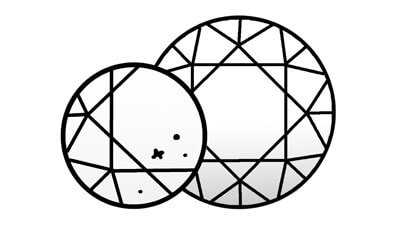
Natural blemishes, called inclusions, from feathers, clouds, or crystals may be found in diamonds.
The locations and sizes of these inclusions factor into the diamond's clarity grade, which can have an extensive impact on the diamond's value. A diamond's clarity is based on a scale, established by the GIA, that ranges from flawless (F) to included (I3), which is very noticeable even to the naked eye. The following is an outline of the GIA clarity grading scale.
A diamond that is absolutely flawless is extremely rare. It is less important that the diamond is perfect, rather than the diamond's attractiveness or durability be affected by any blemish. Diamonds are unique due to the various inclusions that create the character of the stone. The marks that make a diamond unique may be described on a diamond grading report that allows one to identify the diamond if need be.
Obviously, price differences will result from various clarities and blemishes in a diamond. All other factors being equal, moving a diamond from one clarity grade to another can drastically change the value of it.
4. Carat Weight
Carats are the unit of measurement for the weight of diamonds and the diamond carat size is one of the most important factors in determining its value. Each Carat is equal to 200 milligrams. It is easiest to determine a diamond's weight when it is not in a setting. Some gemological laboratories refuse to grade diamonds that are mounted, such as the American Gem Society (AGS) and the Gemological Institute of America's (GIA) Trade Laboratory. Each Carat is divided into 100 parts named "Points".
If a diamond is less than one carat, a range of points is given.
Below is a table of ranges of size and weight.
| Rounds | Squares | Ovals | |||
|---|---|---|---|---|---|
| Size | Weight | Size | Weight | Size | Weight |
| 1.6 mm | .02 carat | 5 mm | .75 carat | 5 x 3 mm | .25 carat |
| 2 mm | .03 carat | 6 mm | 1.3 carat | 6 x 4 mm | .5 carat |
| 2.5 mm | .06 carat | 7 mm | 2.05 carat | 7 x 5 mm | 1.0 carat |
| 3 mm | .10 carat | 8 mm | 2.9 carat | 8 x 6 mm | 1.5 carat |
| 3.5 mm | .16 carat | 9 mm | 4.4 carat | 9 x 7 mm | 2.5 carat |
| 4 mm | .25 carat | 10 mm | 6.0 carat | 10 x 8 mm | 3.0 carat |
| 4.5 mm | .33 carat | 11 mm | 8.0 carat | 11 x 9 mm | 4.0 carat |
| 5 mm | .50 carat | 12 mm | 10.35 carat | 12 x 10 mm | 5.0 carat |
Keep in mind that other qualities affect the value of diamonds. The price of two diamonds of the same weight may vary drastically in price value due to cut, color, and clarity. Additionally, the weight of a diamond can be hidden throughout various areas of the stone. For instance, you may have a diamond that is well-cut and whose weight is dispersed accurately, a diamond that has been cut too deeply to add weight to the base of the stone, or a diamond that has been cut too shallow to make it appear wider and heavier. View our range of Celtic engagement rings here.
Diamond Shape
Stones can be any one of seven shapes. These shapes include marquise, princess, heart, emerald, pear, oval, and round (also named full-cut or brilliant). The shape one would choose would be of his/her own personal preference. The shape of a stone and the cut are not the same thing, so be careful not to use the terms interchangeably. The cut, as previously mentioned, is one of the 4C's of a diamond's evaluation of proportions.
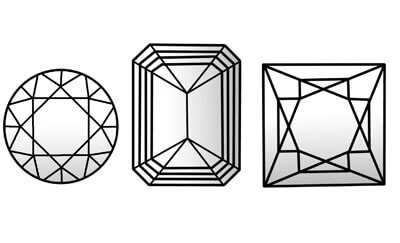
Diamonds can be any one of 7 shapes. These shapes include marquise, princess, heart, emerald, pear, oval, and round.
Many other shapes of stones are also available to project extreme brilliance and fire. The cutter's choice of the shape or diamond cuts he selects is the only variation of the various stone shapes.
The originally mined diamond has a different shape from the final diamond cuts we see in the market. In a process called marking, the roughs are looked-over by a planner who decides how to cut the stone. The planner makes the decision based on how the greatest size, fewest inclusions, and highest brilliance can result.
Most importantly, the planner chooses a technique to cut the diamond without wasting a large amount of it because of the incredible value of the stone.
Diamond Terminology
Diamonds made of pure crystallized carbon are the simplest of all gemstones. A diamond starts to crystallize far away from the earth's surface through a combination of liquids, gases, and crystals. Diamonds can be extremely aged. They may even be from 1 to 3 billion years old. It is the hardest recognized material known to man. Due to its extreme hardness, the only method of cutting or polishing a diamond is to cut or polish it with a different diamond. Nevertheless, a diamond may still be chipped or broken if hit at the right angle; diamonds are not unbreakable.
External Reflection
The stone cutter's skill and attention to detail can be suggested by the polish of the stone. If the stone is bright and lustrous, its polish will be fine. External reflection is the light rays reflected back to the viewer's eyes from the surface of the stone itself. Additionally, the primary light refraction caused by a stone's fire and brilliance inside its facets is referred to as internal refraction. A high degree of external reflection results from finely polished stones.
Facet
The level surfaces on stones are called facets. In order to create the most fire and brilliance of a stone, facets must be cut in precise geometric relation to one another.
Girdle
The area of a stone that rests in the setting and is the furthest boundary of the stone is called the girdle. The girdle also divides the upper and lower sections of the stone. The facet of the stone causes the girdle to differ in thickness.
Hallmark
The Irish Hallmark has existed since 1637 and certifies the prescribed amount of precious metal used in each piece of Irish jewelry. It is one of the most reassuring of quality guarantees and one of the oldest forms of consumer protection.
All jewelry of precious metals made in Ireland must carry a hallmark. The Irish hallmark is distinctive and distinguishes it from imported jewelry.
Ideal Cut
A diamond with the most fire and brilliance follows specific proportions from a certain list of guidelines and is named an ideal cut. The greatest possible fire and brilliance from a diamond comes from a cut of 58 facets.
Inclusion
A recognizable characteristic that naturally occurs in diamonds such as a small crystal, cloud, or feather, is called an inclusion. All other qualities being identical, a diamond with the least amount of inclusions is the most valuable.
Diamonds with fewer inclusions are also less rare than those with more inclusions. Diamonds with absolutely no inclusions are exceptionally rare.
Diamond Settings
Prong Setting
Multiple metal prongs hold the stone in place in a prong setting. The prongs sit above the main portion of the ring and are bent over the top of the stone to secure it. The shape and height of the stone determine the number of prongs used.
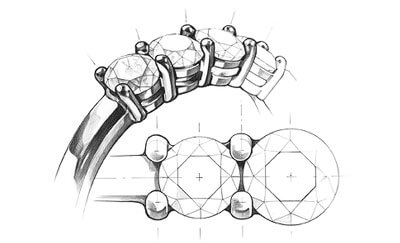
The prongs sit above the main portion of the ring and are bent over the top of the stone to secure it.
Bezel Setting
A stone is held in place by a bezel setting that uses a thin band of metal and surrounds the stone at its girdle, or middle. Depending on the style and desired look of the stone, the bezel setting may completely or partially surround the stone. The middle and bottom (pavilion) portions of the stone are then protected by the setting.
Cluster Setting
Several stones are bunched together when mounted to create a cluster effect. It is common for this setting to have one large stone in the middle surrounded by several smaller ones.
Channel Setting
Two bands of metal that may be made of gold, platinum, or another metal secure the stone in a channel setting, with no metal separating the stones. The girdle area of the stone is securely protected, and small stones are cautiously secured through use of the channel setting. Stones held in place by the channel setting are flush with the top of the mounting to prevent them from getting snagged on objects such as clothing or hair.
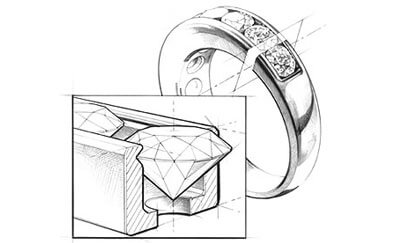
The Channel setting is one of the more secure settings, using two bands of metal to fasten the precious stones.
Bar Setting
The bar setting is much like the channel setting. It is usually used in circular bands and uses a thin piece of metal to secure the stones on either side so that each piece of metal has a stone on both sides of it.
Pavé Setting
Diamonds fit into small divots and are set almost flush with the top of the ring in a pavé setting. The diamonds are typically aligned in rows, with no metal between them. This gives the diamonds a paved look similar to a cobblestone road.
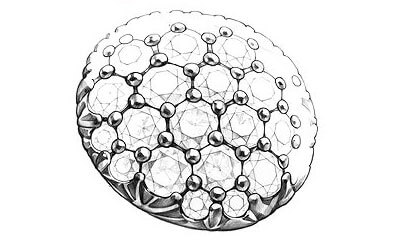
The Pavé setting fits diamonds into small divots and are set flush with the top of the ring.
Tiffany Setting
Originally created by the founder of Tiffany & Co. in 1886, the four to six prong Tiffany setting is extremely popular in wedding rings. The brilliance of the stone is maximized with the prong setting. It allows for the most light to come into the diamond from all directions. Additional security is provided through the use of six prongs.
Did You Know?
The word "Diamond" comes from the Greek word "Adamas" and means "unconquerable and indestructible".
The diamond is a birthstone for people born in the month of April.
Most diamonds found in nature are between one to three billion years old.

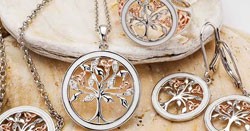
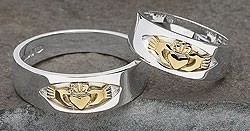
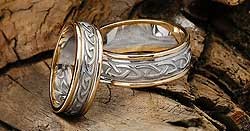
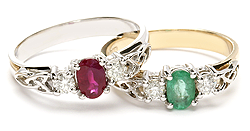
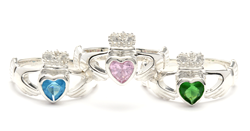
 Trinity Engagement Ring
Trinity Engagement Ring  Sapphire Engagement Ring
Sapphire Engagement Ring  Emerald 3 Stone Ring
Emerald 3 Stone Ring 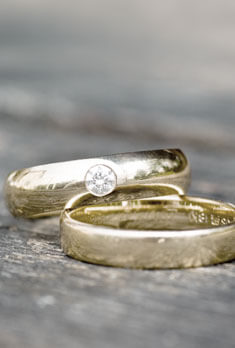

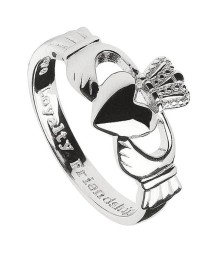 Men's Claddagh Ring
Men's Claddagh Ring  Claddagh Ring Pave
Claddagh Ring Pave 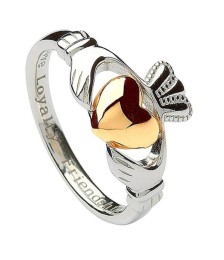 Claddagh with Gold Heart
Claddagh with Gold Heart